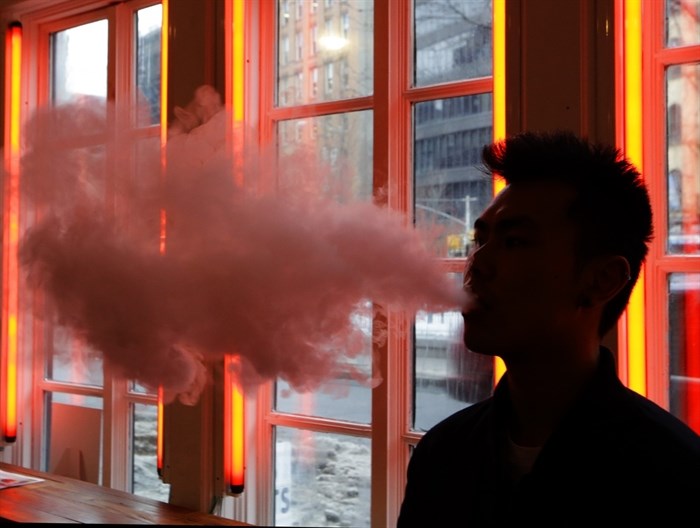
FILE - In this Feb. 20, 2014 file photo, a man exhales vapor from an e-cigarette in New York. Using certain electronic cigarettes at high temperature settings could release much more formaldehyde, a cancer-causing chemical, than smoking traditional cigarettes does, lab tests suggest. The research published in the New England Journal of Medicine on Wednesday, Jan. 21, 2015 is not proof of a risk - it involved limited testing on just one brand of e-cigarettes. But scientists say it shows how little is known about the safety of these popular devices.
Image Credit: (Frank Franklin II/Associated Press)
January 22, 2015 - 5:00 AM
Using certain electronic cigarettes at high temperature settings could potentially release more formaldehyde, a cancer-causing chemical, than smoking traditional cigarettes does, new lab tests suggest.
The research does not prove a health risk — it involved limited testing on just one brand of e-cigarettes and was done in test tubes, not people. It also does not mean e-cigarettes are better or worse than regular ones; tobacco smoke contains dozens of things that can cause cancer.
But it does highlight how little is known about the safety of e-cigarettes — battery-powered devices that heat liquid to deliver nicotine in a vapour rather than from burning tobacco.
"It's a potential red flag," one independent expert — Stephen Hecht, a chemist and tobacco researcher at the University of Minnesota — said of the study. "Under some conditions, e-cigarettes might be generating more formaldehyde than you'd want to be exposed to. But I don't think we know enough yet. There's a huge variety in the makeup of these cigarettes and how they are used."
The study was published Wednesday as a letter in the New England Journal of Medicine. The journal said it had been reviewed by experts in the field.
Formaldehyde is found in many things — certain building materials, disinfectants and embalming fluid. An earlier study found e-cigarettes generated less formaldehyde than regular cigarettes do, but that study looked at just the gas portion of the vapour. The new one looked at the liquid particles in the vapour, like the spray from an aerosol can.
Some tank system e-cigarettes let users turn up the voltage to increase the heat and the amount of liquid, which contains the nicotine and flavourings, in the vapour. David Peyton, a chemist at Portland State University, and colleagues tested one brand with two voltage settings. They used a syringe to collect vapour from 10 samples, each one representing several puffs, at both voltage levels.
They measured formaldehyde hemiacetal — a compound created during the vaping process that under certain conditions can release formaldehyde — in the liquid portion of the vapour.
At low voltage the chemical was not detected. But at the high voltage setting, levels of that compound were five to 15 times greater than the amount of formaldehyde users would get from traditional cigarettes.
Virtually all e-cigarettes use similar materials in the heated liquid, so the finding on formaldehyde "is not brand-dependent," said Peyton, who plans more extensive tests.
However, Gregory Conley, a lawyer with the American Vaping Association, an advocacy group for e-cigarettes, criticized the study methods.
"They use the device in a manner that no one does," he said.
Using the high voltage for as long as the researchers mimicked in the study "creates a burning, acrid taste" called a "dry puff" that would cause users to adjust the e-cigarette, Conley said.
What the researchers did is like leaving a steak on a grill all day — many cancer-causing substances might be formed but no one would eat such charred meat, he said.
Eric Jacobs, a biologist at the American Cancer Society, said a biochemist at the society looked at the work and "was reasonably convinced" that the chemical researchers measured would break down into formaldehyde in the user's lungs.
"No one should conclude from this that e-cigarettes used at high voltage are worse than combustible tobacco cigarettes," because of all the other toxins in tobacco smoke, Jacobs said.
The society's advocacy affiliate, the Cancer Action Network, said the research "should raise serious concerns" about the lack of regulation of e-cigarettes, and urged the Food and Drug Administration to quickly finalize the proposal announced last spring to do so.
News from © The Associated Press, 2015